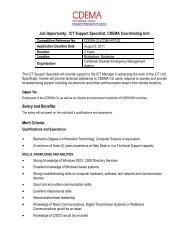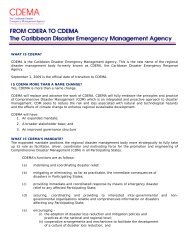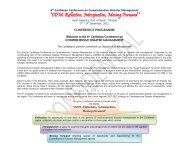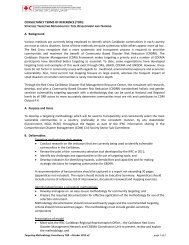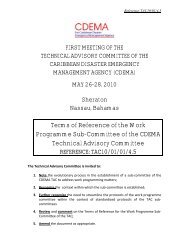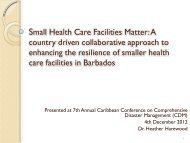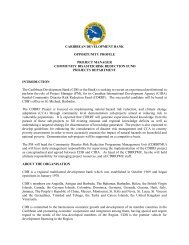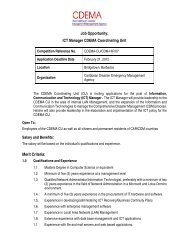You also want an ePaper? Increase the reach of your titles
YUMPU automatically turns print PDFs into web optimized ePapers that Google loves.
a) Making CCDRR gender sensitive<br />
While acute gender-specific disadvantages for women (or men) are not prevalent in the region, gender issues<br />
still require some consideration. Oxfam 3 believes that women’s disadvantage – their unequal access to<br />
resources, legal protection, decision making and power, their reproductive burden, and their vulnerability to<br />
violence – consistently render them more vulnerable than men to the impacts of climate change and disasters.<br />
Women also bring certain advantages. For example, the skills and experience of women in building and<br />
maintaining local social networks can be critical for local disaster risk reduction. Understanding how gender<br />
relations shape women’s and men’s lives is therefore critical to effective climate change adaptation and<br />
disaster risk reduction and must be taken into account in all aspects of the design and delivery of the<br />
Programme.<br />
b) Approaches that take the underlying causes of vulnerability into account<br />
Many approaches to community-based disaster risk reduction fail to include a comprehensive assessment and<br />
subsequent consideration of the underlying causes of vulnerability. Without this information, it is likely that<br />
interventions will have little success in the long term. The IFRC, under its Preparedness for Climate Change<br />
(PfCC) initiative, is working with communities to conduct vulnerability and capacity assessments in vulnerable<br />
communities. This process identifies who is vulnerable and why. A crucial component of the project has been<br />
the recognition that livelihoods are a key aspect of building people’s resilience to various types of risk. Through<br />
its experience of working with communities, the IFRC has developed a wealth of tools and good practice<br />
methodologies aimed at helping to raise awareness, mitigate risks and develop community skills to respond to<br />
disasters.<br />
The CARIBSAVE Partnership has developed a methodology to assess the adaptive capacity and vulnerability<br />
of communities to climate change, and uses a livelihood approach to do this. Households within vulnerable<br />
communities are interviewed to determine their access to the five livelihood assets (financial, physical, natural,<br />
social and human). Livelihood strategies (combinations of assets) are evaluated to determine the adaptive<br />
capacity of households and consequently communities.<br />
c) Approaches that place a strong emphasis on preventative action (building resilience)<br />
Within the Caribbean region, the paradigm shift towards community resilience as part of a comprehensive<br />
disaster management approach predates the Hyogo Framework for Action 2005 – 2015. In its 2001 Strategy<br />
and Results Framework for Comprehensive Disaster Management in the Caribbean, the Caribbean Disaster<br />
and Emergency Response Agency (CDERA), now <strong>CDEMA</strong>, acknowledged the community approach as an<br />
“effective way of selling integration of disaster mitigation to the population” because it can be applied on a<br />
scale and in terms that resonate at the local level. This shift to disaster risk reduction has also been a key<br />
feature in the IFRC’s work with communities in the Caribbean to reduce their vulnerability through raising<br />
awareness, consideration of existing community coping mechanisms, capacity building and participatory<br />
approaches to increasing their resilience.<br />
d) Strategies developed with communities<br />
Community involvement in the design of response strategies is critical and should be initiated from the outset.<br />
The IFRC, through its Regional Disaster Management Framework, and particularly the community disaster<br />
preparedness training to conduct vulnerability and capacity assessments, involves community members in the<br />
development of the tools which they will subsequently use to reduce the community’s vulnerability to disasters.<br />
The approach includes community identification of the perceived risks and capacities to generate a<br />
vulnerability maps and early warning systems.<br />
The Building Disaster Resilient Communities (BDRC) Project being implemented in 28 communities in Jamaica<br />
has engaged, and continues to engage, stakeholders in defining their own problems and solutions to inform<br />
3 Oxfam GB, 2010. Gender, Disaster Risk Reduction, and Climate Change Adaptation: A Learning Companion Oxfam Disaster Risk<br />
Reduction and Climate Change Adaptation Resources.<br />
4



